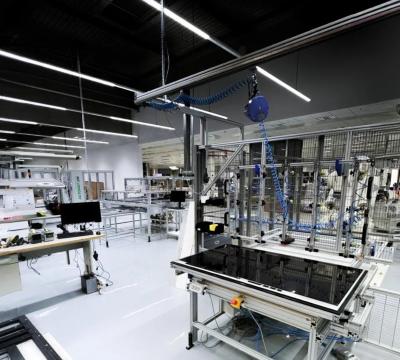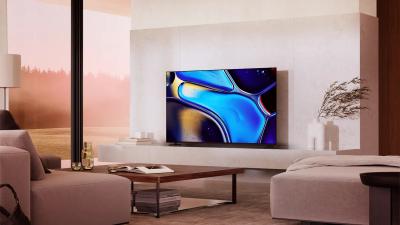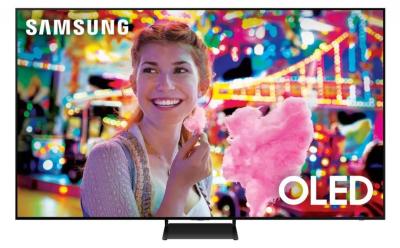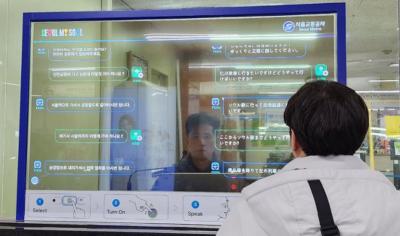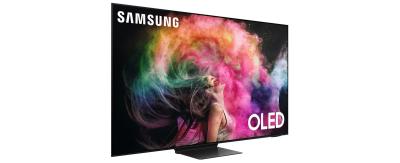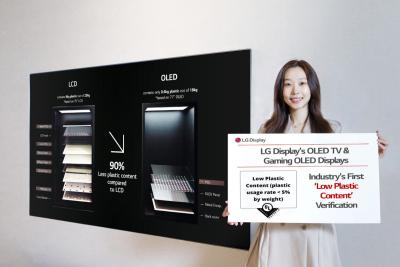What is an OLED TV?
OLED TVs use a display technology called OLED (Organic Light Emitting Diodes) that enables displays that are brighter, more efficient, thinner, flexible and with higher contrast and faster refresh rates than either LCD. Simply put, OLED TVs deliver the best picture quality ever!
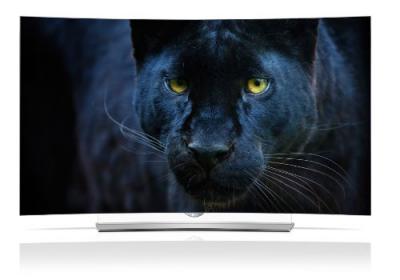
OLED TV technology
Each pixel in an OLED TV emits light on its own (in fact each pixel is made from 3 different OLEDs, red, green and blue). OLEDs are truly emissive devices with a simple design which gives them many advantages over current LCD technology:
- High contrast: in OLEDs we have true blacks as when a pixel is off it does not emit any light. In LCDs, the backlighting is always on and so true blacks are impossible to achieve. Even when compared to the latest high-end mini-LED backlit LCDs, the contrast of OLEDs is superior.
- High refresh rates: OLEDs can switch on and off much faster than LCDs.
- Better power consumption: OLEDs only consume light on lit pixels - as opposed to LCDs who always need to use the backlighting. The power consumption of OLEDs depends on the image shown, but in most cases OLEDs will be more efficient than LCDS.
- Flexibility: the simple design of OLEDs enables next-generation flexible, bendable, foldable and even rollable displays. LG is now shipping the world's first rollable TV, the 65" 65RX.
Click here for a more in-depth comparison between LCDs and OLEDs.
OLED TVs on the market - what can you buy today?
As of 2022, the leading company that produces OLED TV panels is LG Display - making panels ranging from 42-inch to 97-inch. These OLEDs offer the best image quality of all TVs on the market today. LGD is offering its OLED panels to many companies, including LG Electronics, Sony, Vizio and Panasonic.
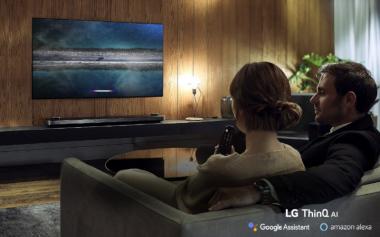
In 2022 Samsung joined LGD and started to produce its own OLED TV variant, called QD-OLED (which is based on blue OLED emitters and quantum dots color conversion technology). Samsung is producing 55-inch and 65-inch QD-OLED TV panels.
There are dozens of models available today, ranging from entry-level OLED TVs to high-end rollable, bendable and even transparent ones. Click here for the latest OLED TVs on the market.
Reviews of OLED TVs are terrific, and most experts and consumers agree that these OLED TVs are the best TVs ever produced - with virtually perfect image quality and beautiful form factors.
Direct Emission vs WRGB / QD-OLED
The most straightforward OLED architecture uses 3 color OLED sub-pixels (Red, Green and Blue) to create each 'pixel'. This is referred to as a direct emission OLED, and is the design used in mobile OLED displays (for example those used in Apple's latest iPhones and Watches).
For its OLED TVs, however, LG Display is using a different architecture, called WRGB (or WOLED-CF) which uses four white OLED subpixels (each created by using both blue and yellow OLED emitters) with color filters on top (RBG and W). The WRGB technology (developed by Kodak and now owned by LG Display) was found to be easier to scale-up for large-area OLED production, although it suffers from lower efficiency and more complicated design.
As we stated, Samsung's OLED TV architecture is based on blue OLED emitters and quantum-dots color conversion layers.
Further reading
The latest OLED TV news:
LG Electronics to discontinue its 65" rollable OLED TV, after 5 years of slow sales
In early 2019, LG launched the world's first rollable OLED device - a TV that rolls into its base. The 65" Signature OLED TV R had three viewing options - full view, line view and zero view, and was heralded as a radical new TV form factor. The OLED TV R had a high price tag (around $100,000) and obviously never attracted a large customer base.
LG Electronics now decided to stop selling the TV, and not release a new edition. It actually disbanded its small dedicated production line, and will now focus on other high-end premium TVs instead, such as the transparent Signature OLED T TV.
Loewe inaugurates Europe's first open-cell OLED TV assembly line
Germany-based Loewe announced that it has established its own OLED TV assembly line, at its headquarters in Kronach, Germany. The new facility is said to be based on a 'radically designed' production process, and it is staffed by around 200 employees. The line will begin full-scale production by the end of May.
Loewe revealed that it is buying 'open-cell' WOLED panels from LG Display - and this is the first production line in Europe that can work with such panels (as opposed to complete OLED modules used in all other EU-based lines). Working with open-cell panels enables Loewe to have more control over the process and the design of its premium TVs.
Sony launches its 2024 TV lineup, with a mid-range OLED TV and a top-tier MiniLED backlit QLED
Sony announced its 2024 TV lineup, and interestingly, the top model (the Bravia 9) is a Mini-LED backlit QLED TV. The entry-level model (the Bravia 7) is also a QLED display, while the mid-range model, the Bravia 8, is based on LGD's WOLED panels.
The Bravia 8 offers 55-, 65- and 77 inch 4K WOLED panels, Sony's OLED Acoustic Surface Audio+ sound system, an upgraded XR Processor, and the creator calibration picture settings. Sony's 2024 TVs will launch in the summer of 2024.
LG Display to increase its WOLED panel shipments to Samsung, will reach almost 1 million units in 2024
According to a new report in Korea, LG Display aims to increase its OLED TV panel shipments to Samsung Electronics in 2024, and to reach almost 1 million units.
Samsung has recently signed a five-year OLED TV panel supply agreement with LG Display, as the two Korean companies are increasing their collaboration to fend off competition from China.
Seoul Metro installs more transparent OLED based AI translation services throughout the city
Towards the end of 2023, Seoul's Metropolitan Government has initiated a new pilot test at Myeong-dong Station that offers an AI-powered translation service for tourists that enables them to communicate with the subway staff through a transparent 55" LG OLED display.
The pilot was successful, and Seoul's Metro expanded the service to 11 stations, throughout Seoul. This is one of the first useful applications of transparent OLED displays, and it is great to see it expanded in Korea. We do not know whether there are any plans to roll out more such displays in Korea.
Samsung's upcoming S90D OLED TV lineup will feature displays utilizing both WOLED QD-OLED panels
According to reports from Korea, LG Display requested Samsung Electronics to use its WOLED panels on the same tier as SDC's QD-OLED panels, and Samsung will use both panel technologies in its S90D OLED TV series. Samsung will likely not disclose the actual panel technology to the consumer, and will likely decide on the panel technology per region.
The Samsung S90D will offer 42-, 48-, 55-, 65-, 77- and 83-inch panels. SDC only makes 55, 65, and 77-inch QD-OLED panels, and so in these sizes both QD-OLEDs and WOLEDs will be used. For the 42-, 48- and 83- models Samsung will only use WOLEDs.
LG Display's WOLED panels receive new low-plastic and eco-friendliness certifications from UL and SGS
LG Display says that its WOLED TV and gaming displays have been awarded UL's low-plastic verification, given to products in which the plastic usage accounts to less than 5% of their total weight.
LGD says that its 65-inch OLED TV panel contains about 4% plastic content, about 905 lower than to a 65" LCD panel. In addition, by substituting key components with easily recyclable materials, LG Display has increased the recyclability of parts to as high as 92.7% at disposal.
Samsung: we sold 1 million OLED TVs in 2023 and had a market share of 22.7% in the OLED TV market
Samsung announced that in 2023 it retained its market-leading position in the TV mraket, with a 30.1% market share (revenues). The company also disclosed that it sold 1.01 million OLED TVs in 2023 - mostly QD-OLED TVs, and some WOLED TVs as well.
Samsung quotes Omdia saying that it had a 22.7% market share in the OLED TV Market (by revenue), which is pretty impressive, as the company is relatively very new to this market.
LG Display said to be progressing with its 8.6-Gen IT AMOLED line plans, to announce its plans in H2 2024
According to recent rumors, LG Display has decided to go ahead and build its 8.6-Gen (2250 x 2600 mm) IT AMOLED line, in Paju, Korea (at its P10 hub, which was originally planned for OLED TV production). The company recently started to conduct discussions with equipment makers for supply agreements.
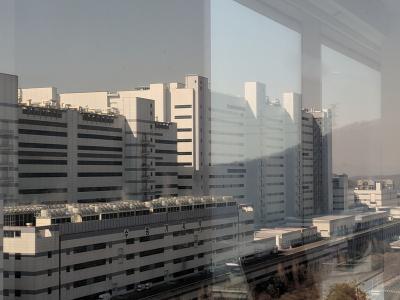
LG Display's plan is to officially announce its 8.6-Gen production line plans in the second half of the year, and start ordering equipment. It is likely that the capacity of the fab will be between 7,500 to 15,000 monthly substrates. LG will be using its P10 building and existing equipment (backplane deposition) to reduce the costs of the 8.6-Gen line. This will mean that there will be delays to LG's WOLED TV panel capacity expansion plans.
Samsung Electronics signs a 5-year WOLED supply agreement with LG Display
In July 2023, Samsung Electronics officially launched the 83" 83S90C, the company's first TV to use LG's WOLED panels, following several years of negotiations and hesitation by the Korean rivals. Samsung then continued to launch more WOLED TVs, but did not made large orders, as it mainly uses QD-OLED panels from SDC for its high-end TVs.
According to a new report, Samsung Electronics has signed a five-year WOLED supply agreement with LG Display. This is an interesting development that may have implications for Samsung Display's QD-OLED production plans. We do not have more details, it will be interesting to learn what kind of volumes Samsung committed to.
Pagination
- Page 1
- Next page


